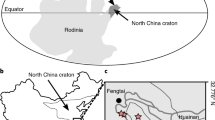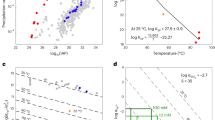Abstract
The chemical composition of the ocean changed markedly with the oxidation of the Earth’s surface1, and this process has profoundly influenced the evolutionary and ecological history of life2,3. The early Earth was characterized by a reducing ocean–atmosphere system, whereas the Phanerozoic eon (less than 542 million years ago) is known for a stable and oxygenated biosphere conducive to the radiation of animals. The redox characteristics of surface environments during Earth’s middle age (1.8–1 billion years ago) are less well known, but it is generally assumed that the mid-Proterozoic was home to a globally sulphidic (euxinic) deep ocean2,3. Here we present iron data from a suite of mid-Proterozoic marine mudstones. Contrary to the popular model, our results indicate that ferruginous (anoxic and Fe2+-rich) conditions were both spatially and temporally extensive across diverse palaeogeographic settings in the mid-Proterozoic ocean, inviting new models for the temporal distribution of iron formations and the availability of bioessential trace elements during a critical window for eukaryotic evolution.
This is a preview of subscription content, access via your institution
Access options
Subscribe to this journal
Receive 51 print issues and online access
$199.00 per year
only $3.90 per issue
Buy this article
- Purchase on Springer Link
- Instant access to full article PDF
Prices may be subject to local taxes which are calculated during checkout


Similar content being viewed by others
References
Holland, H. D. Sedimentary mineral deposits and the evolution of Earth’s near-surface environments. Econ. Geol. 100, 1489–1509 (2005)
Canfield, D. E. The early history of atmospheric oxygen: homage to Robert A. Garrels. Annu. Rev. Earth Planet. Sci. 33, 1–36 (2005)
Lyons, T. W., Anbar, A., Severmann, S., Scott, C. & Gill, B. Tracking euxinia in the ancient ocean: a multiproxy perspective and Proterozoic case study. Annu. Rev. Earth Planet. Sci. 37, 507–534 (2009)
Canfield, D. E. A new model for Proterozoic ocean chemistry. Nature 396, 450–453 (1998)
Lyons, T. W., Reinhard, C. T. & Scott, C. Redox redux. Geobiology 7, 489–494 (2009)
Poulton, S. W., Fralick, P. W. & Canfield, D. E. The transition to a sulphidic ocean similar to 1.84 billion years ago. Nature 431, 173–177 (2004)
Anbar, A. D. & Knoll, A. H. Proterozoic ocean chemistry and evolution: a bioinorganic bridge. Science 297, 1137–1142 (2002)
Bekker, A. et al. Iron formation: the sedimentary product of a complex interplay among mantle, tectonic, oceanic, and biospheric processes. Econ. Geol. 105, 467–508 (2010)
Wilson, J. P. et al. Geobiology of the late Paleoproterozoic Duck Creek Formation, Western Australia. Precambr. Res. 179, 135–149 (2010)
Poulton, S. W., Fralick, P. W. & Canfield, D. E. Spatial variability in oceanic redox structure 1.8 billion years ago. Nature Geosci. 3, 486–490 (2010)
Poulton, S. W. & Canfield, D. E. Ferruginous conditions: a dominant feature of the ocean through Earth’s history. Elements 7, 107–112 (2011)
Canfield, D. E. et al. Ferruginous conditions dominated later Neoproterozoic deep-water chemistry. Science 321, 949–952 (2008)
Johnston, D. T. et al. An emerging picture of Neoproterozoic ocean chemistry: insights from the Chuar Group, Grand Canyon, USA. Earth Planet. Sci. Lett. 290, 64–73 (2010)
Li, C. et al. A stratified redox model for the Ediacaran Ocean. Science 328, 80–83 (2010)
Swanson-Hysell, N. L. et al. Cryogenian glaciation and the onset of carbon-isotope decoupling. Science 328, 608–611 (2010)
Brocks, J. J. et al. Biomarker evidence for green and purple sulphur bacteria in a stratified Palaeoproterozoic sea. Nature 437, 866–870 (2005)
Johnston, D. T. et al. Sulfur isotope biogeochemistry of the Proterozoic McArthur Basin. Geochim. Cosmochim. Acta 72, 4278–4290 (2008)
Poulton, S. W. & Canfield, D. E. Development of a sequential extraction procedure for iron: implications for iron partitioning in continentally derived particulates. Chem. Geol. 214, 209–221 (2005)
Raiswell, R. Turbidite depositional influences on the diagenesis of Beecher’s Trilobite Bed and the Hunsrück Slate; sites of soft tissue pyritization. Am. J. Sci. 305, 105–129 (2008)
Kendall, B., Creaser, R. A., Gordon, G. W. & Anbar, A. D. Re–Os and Mo isotope systematics of black shales from the Middle Proterozoic Velkerri and Wollogorang Formations, McArthur Basin, northern Australia. Geochim. Cosmochim. Acta 73, 2534–2558 (2009)
Shen, Y., Knoll, A. H. & Walter, M. R. Evidence for low sulphate and anoxia in a mid-Proterozoic marine basin. Nature 423, 632–635 (2003)
McGoldrick, P., Winefield, P., Bull, S., Selley, D. & Scott, R. Sequences, synsedimentary structures, and sub-basins: the where and when of SEDEX zinc systems in the southern McArthur Basin, Australia. Soc. Econ. Geol. Spec. Publ. 15, 1–23 (2010)
Lyons, T. W., Luepke, J. J., Schreiber, M. E. & Zieg, G. A. Sulfur geochemical constraints on Mesoproterozoic restricted marine deposition: lower Belt Supergroup, northwestern United States. Geochim. Cosmochim. Acta 64, 427–437 (2000)
Kendall, B. et al. Pervasive oxygenation along late Archaean ocean margins. Nature Geosci. 3, 647–652 (2010)
Reinhard, C. T., Raiswell, R., Scott, C., Anbar, A. D. & Lyons, T. W. A Late Archean sulfidic sea stimulated by early oxidative weathering of the continents. Science 326, 713–716 (2009)
Scott, C. et al. Late Archean euxinic conditions before the rise of atmospheric. Geology 39, 119–122 (2011)
Scott, C. et al. Tracing the stepwise oxygenation of the Proterozoic ocean. Nature 452, 457–460 (2008)
Bekker, A. et al. Fractionation between inorganic and organic carbon during the Lomagundi (2.22–2.1 Ga) carbon isotope excursion. Earth Planet. Sci. Lett. 271, 278–291 (2008)
Slack, J. F., Grenne, T., Bekker, A., Rouxel, O. J. & Lindberg, P. A. Suboxic deep seawater in the late Paleoproterozoic: evidence from hematitic chert and iron formation related to seafloor-hydrothermal sulfide deposits, central Arizona, USA. Earth Planet. Sci. Lett. 255, 243–256 (2007)
Kump, L. R. & Seyfried, W. E. Hydrothermal Fe fluxes during the Precambrian: effect of low oceanic sulfate concentrations and low hydrostatic pressure on the composition of black smokers. Earth Planet. Sci. Lett. 235, 654–662 (2005)
David, L. A. & Alm, E. J. Rapid evolutionary innovation during an Archaean genetic expansion. Nature 469, 93–96 (2011)
Chu, X., Zhang, T., Zhang, Q. & Lyons, T. W. Sulfur and carbon isotope records from 1700 to 800 Ma carbonates of the Jixian section, northern China: Implications for secular isotope variations in Proterozoic seawater and relationships to global supercontinental events. Geochim. Cosmochim. Acta 71, 4668–4692 (2007)
Gellatly, A. M. & Lyons, T. W. Trace sulfate in mid-Proterozoic carbonates and the sulfur isotope record of biospheric evolution. Geochim. Cosmochim. Acta 69, 3813–3829 (2005)
Acknowledgements
We thank P. Emsbo, S. Bull and D. Winston for formative discussions, P. Fralick for constructive comments, and S. Bates and J. Owens for assistance with the analyses. This work was supported by funding from the National Science Foundation (NSF) Graduate Research Fellowship programme, Geological Society of America and American Philosophical Society, to N.J.P.; from the NSF Division of Earth Sciences, the NASA Exobiology Program and Astrobiology Institute and the UTAS Visiting Fellows programme to T.W.L.; from the Agouron Institute to T.W.L. and G.D.L; and from Natural Sciences and Engineering Research Council of Canada to A.B. P.McG. was supported through the Australian Research Council’s Centre of Excellence programme.
Author information
Authors and Affiliations
Contributions
P.McG., A.B., T.W.L., X.C., C.L. and N.J.P. collected samples, and P.McG., N.J.P., C.T.S. and C.L. analysed them. All authors were involved in the writing and the design and interpretations of this study.
Corresponding author
Ethics declarations
Competing interests
The authors declare no competing financial interests.
Supplementary information
Supplementary Information
The file contains Supplementary Text, Supplementary References, Supplementary Figure 1 with a legend and Supplementary Table 1. (PDF 2408 kb)
PowerPoint slides
Rights and permissions
About this article
Cite this article
Planavsky, N., McGoldrick, P., Scott, C. et al. Widespread iron-rich conditions in the mid-Proterozoic ocean. Nature 477, 448–451 (2011). https://doi.org/10.1038/nature10327
Received:
Accepted:
Published:
Issue Date:
DOI: https://doi.org/10.1038/nature10327
This article is cited by
-
A phosphate-rich marine reservoir in the redox stratified Ediacaran ocean
Communications Earth & Environment (2024)
-
Dynamic redox and nutrient cycling response to climate forcing in the Mesoproterozoic ocean
Nature Communications (2023)
-
Influence of sulfide on diazotrophic growth of the methanogen Methanococcus maripaludis and its implications for the origin of nitrogenase
Communications Biology (2023)
-
Differentiating between hydrothermal and diagenetic carbonate using rare earth element and yttrium (REE+Y) geochemistry: a case study from the Paleoproterozoic George Fisher massive sulfide Zn deposit, Mount Isa, Australia
Mineralium Deposita (2022)
-
Nitrogen Isotopes from the Neoproterozoic Liulaobei Formation, North China: Implications for Nitrogen Cycling and Eukaryotic Evolution
Journal of Earth Science (2022)
Comments
By submitting a comment you agree to abide by our Terms and Community Guidelines. If you find something abusive or that does not comply with our terms or guidelines please flag it as inappropriate.



